MITSUBISHI ASX 2017 Owner's Manual (in English)
Manufacturer: MITSUBISHI, Model Year: 2017, Model line: ASX, Model: MITSUBISHI ASX 2017Pages: 458, PDF Size: 22.98 MB
Page 341 of 458
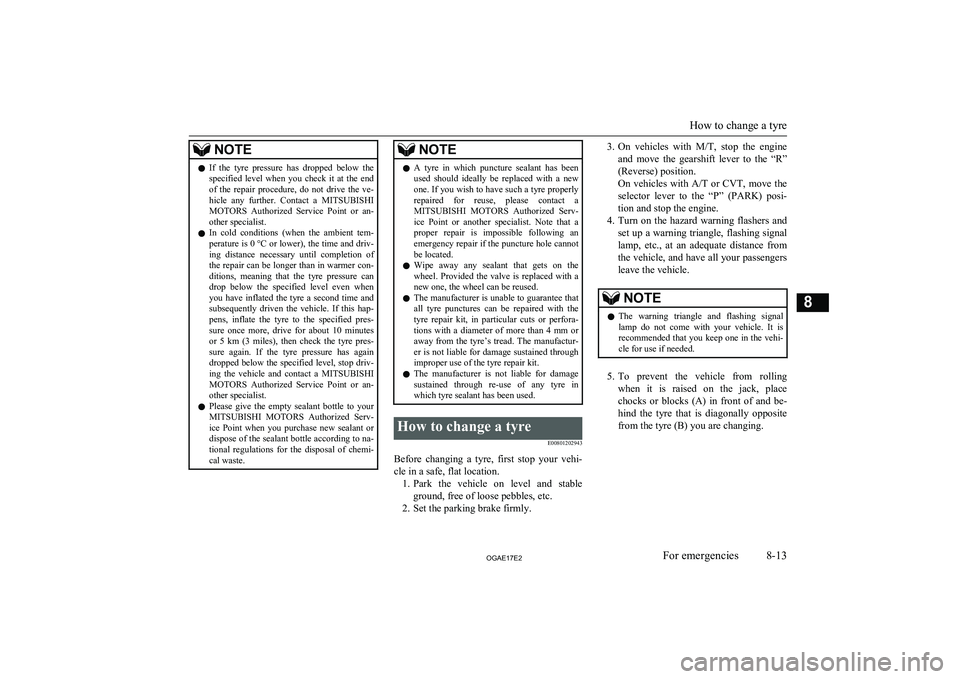
NOTElIf the tyre pressure has dropped below the
specified level when you check it at the end
of the repair procedure, do not drive the ve- hicle any further. Contact a MITSUBISHI
MOTORS Authorized Service Point or an-
other specialist.
l In cold conditions (when the ambient tem-
perature is 0 °C or lower), the time and driv-
ing distance necessary until completion of
the repair can be longer than in warmer con- ditions, meaning that the tyre pressure candrop below the specified level even when
you have inflated the tyre a second time and
subsequently driven the vehicle. If this hap- pens, inflate the tyre to the specified pres-
sure once more, drive for about 10 minutes or 5 km (3 miles), then check the tyre pres-sure again. If the tyre pressure has again
dropped below the specified level, stop driv- ing the vehicle and contact a MITSUBISHI
MOTORS Authorized Service Point or an-
other specialist.
l Please give the empty sealant bottle to your
MITSUBISHI MOTORS Authorized Serv-
ice Point when you purchase new sealant or
dispose of the sealant bottle according to na- tional regulations for the disposal of chemi-
cal waste.NOTEl A tyre in which puncture sealant has been
used should ideally be replaced with a newone. If you wish to have such a tyre properly
repaired for reuse, please contact a MITSUBISHI MOTORS Authorized Serv-
ice Point or another specialist. Note that a
proper repair is impossible following an emergency repair if the puncture hole cannot
be located.
l Wipe away any sealant that gets on the
wheel. Provided the valve is replaced with a
new one, the wheel can be reused.
l The manufacturer is unable to guarantee that
all tyre punctures can be repaired with the tyre repair kit, in particular cuts or perfora-
tions with a diameter of more than 4 mm or
away from the tyre’s tread. The manufactur-
er is not liable for damage sustained through improper use of the tyre repair kit.
l The manufacturer is not liable for damage
sustained through re-use of any tyre in
which tyre sealant has been used.How to change a tyre
E00801202943
Before changing a tyre, first stop your vehi-cle in a safe, flat location. 1. Park the vehicle on level and stable
ground, free of loose pebbles, etc.
2. Set the parking brake firmly.
3. On vehicles with M/T, stop the engine
and move the gearshift lever to the “R”
(Reverse) position.
On vehicles with A/T or CVT, move the
selector lever to the “P” (PARK) posi- tion and stop the engine.
4. Turn on the hazard warning flashers and
set up a warning triangle, flashing signal
lamp, etc., at an adequate distance from the vehicle, and have all your passengers
leave the vehicle.NOTEl The warning triangle and flashing signal
lamp do not come with your vehicle. It is recommended that you keep one in the vehi- cle for use if needed.
5. To prevent the vehicle from rolling
when it is raised on the jack, place
chocks or blocks (A) in front of and be- hind the tyre that is diagonally opposite
from the tyre (B) you are changing.
How to change a tyre
8-13OGAE17E2For emergencies8
Page 342 of 458
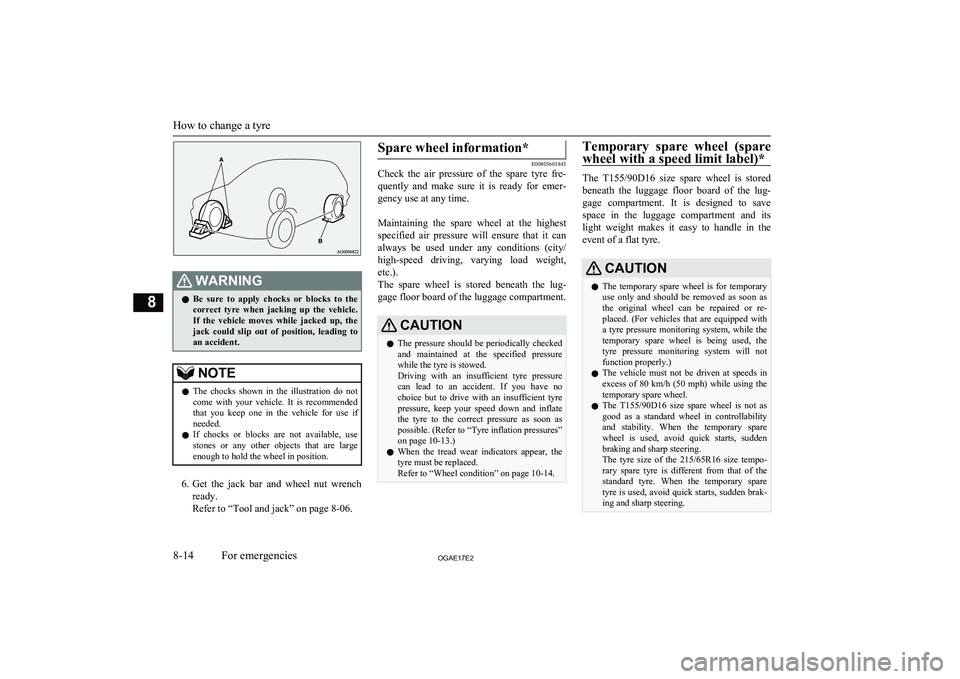
WARNINGlBe sure to apply chocks or blocks to the
correct tyre when jacking up the vehicle.If the vehicle moves while jacked up, the
jack could slip out of position, leading to
an accident.NOTEl The chocks shown in the illustration do not
come with your vehicle. It is recommended
that you keep one in the vehicle for use if needed.
l If chocks or blocks are not available, use
stones or any other objects that are large enough to hold the wheel in position.
6. Get the jack bar and wheel nut wrench
ready.
Refer to “Tool and jack” on page 8-06.
Spare wheel information*
E00803601843
Check the air pressure of the spare tyre fre-
quently and make sure it is ready for emer-
gency use at any time.
Maintaining the spare wheel at the highest specified air pressure will ensure that it can
always be used under any conditions (city/ high-speed driving, varying load weight,etc.).
The spare wheel is stored beneath the lug-
gage floor board of the luggage compartment.
CAUTIONl The pressure should be periodically checked
and maintained at the specified pressure while the tyre is stowed.
Driving with an insufficient tyre pressure
can lead to an accident. If you have no choice but to drive with an insufficient tyre
pressure, keep your speed down and inflate the tyre to the correct pressure as soon as
possible. (Refer to “Tyre inflation pressures”
on page 10-13.)
l When the tread wear indicators appear, the
tyre must be replaced.
Refer to “Wheel condition” on page 10-14.Temporary spare wheel (spare
wheel with a speed limit label)*
The T155/90D16 size spare wheel is stored
beneath the luggage floor board of the lug-
gage compartment. It is designed to save
space in the luggage compartment and its light weight makes it easy to handle in the event of a flat tyre.
CAUTIONl The temporary spare wheel is for temporary
use only and should be removed as soon as
the original wheel can be repaired or re- placed. (For vehicles that are equipped with a tyre pressure monitoring system, while the
temporary spare wheel is being used, the
tyre pressure monitoring system will not
function properly.)
l The vehicle must not be driven at speeds in
excess of 80 km/h (50 mph) while using the temporary spare wheel.
l The
T155/90D16 size spare wheel is not as
good as a standard wheel in controllability and stability. When the temporary spare
wheel is used, avoid quick starts, sudden braking and sharp steering.
The tyre size of the 215/65R16 size tempo-
rary spare tyre is different from that of the standard tyre. When the temporary spare
tyre is used, avoid quick starts, sudden brak- ing and sharp steering.
How to change a tyre
8-14OGAE17E2For emergencies8
Page 343 of 458
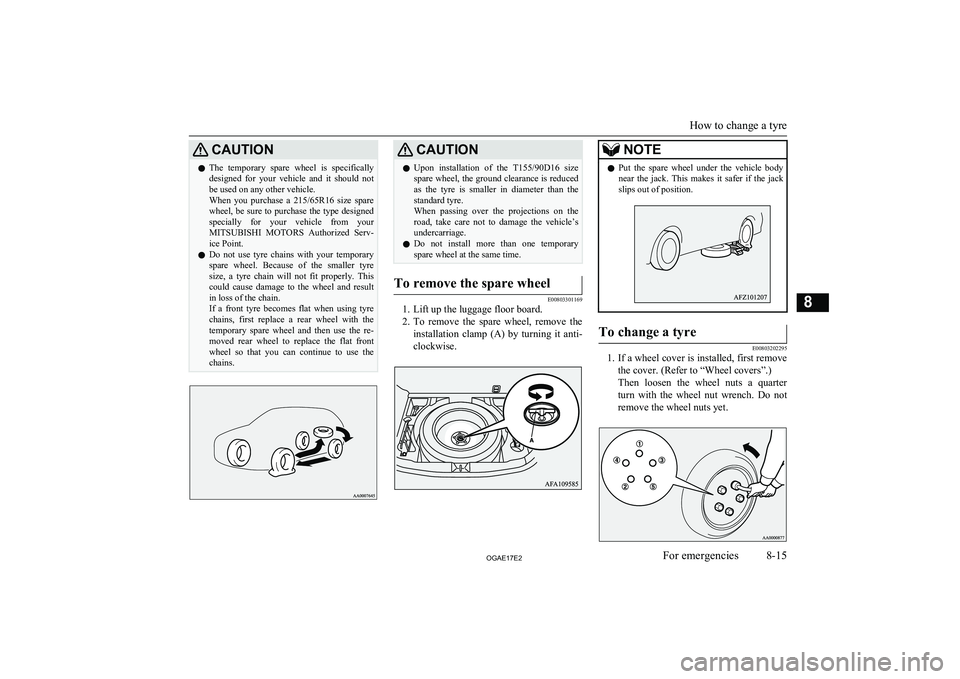
CAUTIONlThe temporary spare wheel is specifically
designed for your vehicle and it should not
be used on any other vehicle.
When you purchase a 215/65R16 size spare
wheel, be sure to purchase the type designed
specially for your vehicle from your
MITSUBISHI MOTORS Authorized Serv-
ice Point.
l Do not use tyre chains with your temporary
spare wheel. Because of the smaller tyresize, a tyre chain will not fit properly. This
could cause damage to the wheel and result in loss of the chain.
If a front tyre becomes flat when using tyre
chains, first replace a rear wheel with the temporary spare wheel and then use the re-
moved rear wheel to replace the flat front
wheel so that you can continue to use the chains.CAUTIONl Upon installation of the
T155/90D16 size
spare wheel, the ground clearance is reduced as the tyre is smaller in diameter than thestandard tyre.
When passing over the projections on the road, take care not to damage the vehicle’s
undercarriage.
l Do not install more than one temporary
spare wheel at the same time.To remove the spare wheel
E00803301169
1. Lift up the luggage floor board.
2. To remove the spare wheel, remove the
installation clamp (A) by turning it anti-
clockwise.
NOTEl Put the spare wheel under the vehicle body
near the jack. This makes it safer if the jack slips out of position.To change a tyre
E00803202295
1. If a wheel cover is installed, first remove
the cover. (Refer to “Wheel covers”.)
Then loosen the wheel nuts a quarter
turn with the wheel nut wrench. Do not remove the wheel nuts yet.
How to change a tyre
8-15OGAE17E2For emergencies8
Page 344 of 458
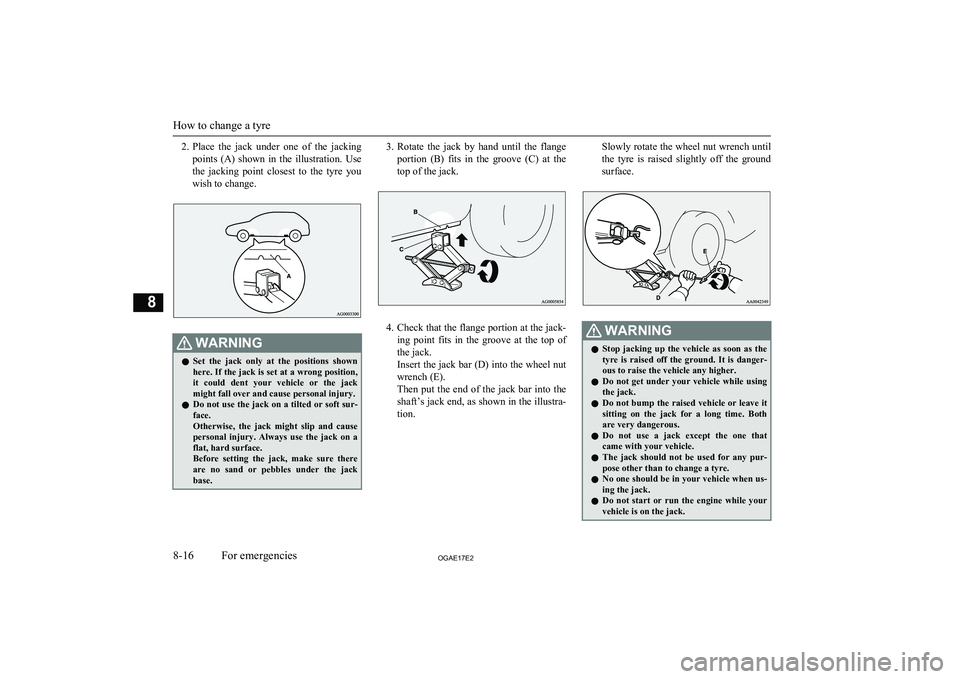
2.Place the jack under one of the jacking
points (A) shown in the illustration. Use
the jacking point closest to the tyre you wish to change.WARNINGl Set the jack only at the positions shown
here. If the jack is set at a wrong position, it could dent your vehicle or the jack
might fall over and cause personal injury.
l Do not use the jack on a tilted or soft sur-
face.
Otherwise, the jack might slip and cause
personal injury. Always use the jack on a flat, hard surface.
Before setting the jack, make sure there
are no sand or pebbles under the jack base.3. Rotate the jack by hand until the flange
portion (B) fits in the groove (C) at the
top of the jack.
4. Check that the flange portion at the jack-
ing point fits in the groove at the top of the jack.
Insert the jack bar (D) into the wheel nut
wrench (E).
Then put the end of the jack bar into the
shaft’s jack end, as shown in the illustra- tion.
Slowly rotate the wheel nut wrench until
the tyre is raised slightly off the ground
surface.WARNINGl Stop jacking up the vehicle as soon as the
tyre is raised off the ground. It is danger-
ous to raise the vehicle any higher.
l Do not get under your vehicle while using
the jack.
l Do not bump the raised vehicle or leave it
sitting on the jack for a long time. Both are very dangerous.
l Do not use a jack except the one that
came with your vehicle.
l The jack should not be used for any pur-
pose other than to change a tyre.
l No one should be in your vehicle when us-
ing the jack.
l Do not start or run the engine while your
vehicle is on the jack.
How to change a tyre
8-16OGAE17E2For emergencies8
Page 345 of 458

WARNINGlDo not turn the raised wheel. The tyres
still on the ground could turn and make
your vehicle fall off the jack.
5. Remove the wheel nuts with the wheel
nut wrench, then take the wheel off.
CAUTIONl Handle the wheel carefully when changing
the tyre, to avoid scratching the wheel sur- face.
6. Clean out any mud, etc. on the hub sur-
face (F), hub bolts (G) or in the installa- tion holes (H) in the wheel, and then
mount the spare tyre.
WARNINGl Be sure to position the tyres the correct
way when putting them on the vehicle.
The valves should be on the outer side of
the vehicle. If the valve (I) cannot be seen, the tyre has been mounted the wrong wayaround.
If tyres are mounted the wrong way
around it could have a negative effect on the vehicle and cause an accident.
7. Turn the wheel nuts clockwise by hand
to initially tighten them.
[Vehicle with the tapered nuts]
Initially tighten the wheel nuts until the tapered part (A) of the nuts lightly
touches the wheel hole seats (B) enough
to keep the tyre from wobbling.
[Vehicle with the flange nuts] • Aluminium wheelInitially tighten the wheel nuts until
the wheel nut flange area (C) touch-
es the wheel enough to keep the tyre
from wobbling.
• Steel wheel
How to change a tyre
8-17OGAE17E2For emergencies8
Page 346 of 458
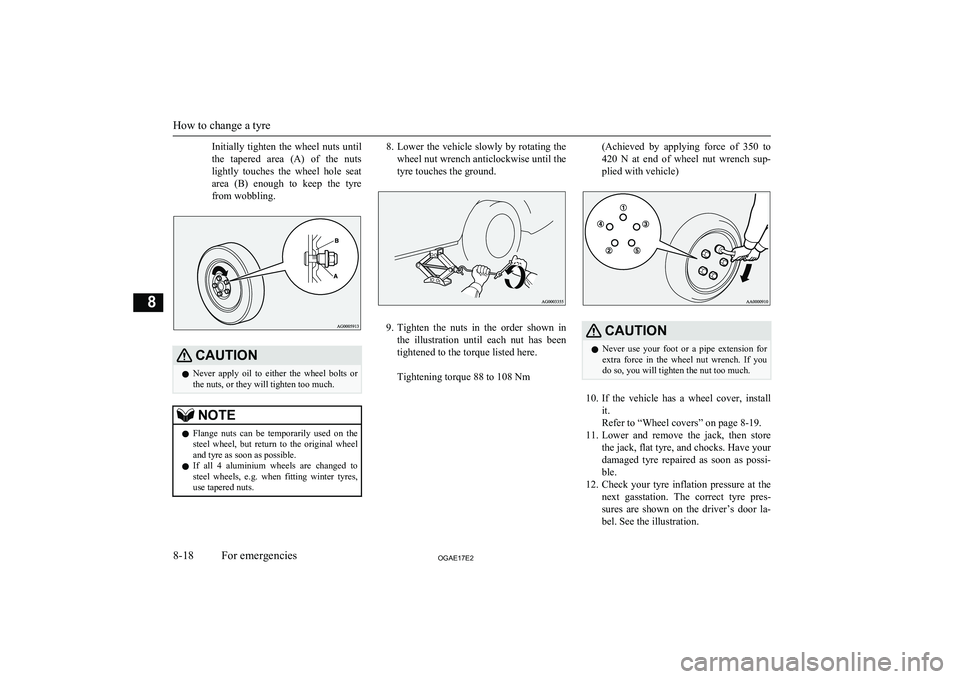
Initially tighten the wheel nuts until
the tapered area (A) of the nuts
lightly touches the wheel hole seat
area (B) enough to keep the tyre from wobbling.CAUTIONl Never apply oil to either the wheel bolts or
the nuts, or they will tighten too much.NOTEl Flange nuts can be temporarily used on the
steel wheel, but return to the original wheel and tyre as soon as possible.
l If all 4 aluminium wheels are changed to
steel wheels, e.g. when fitting winter tyres,
use tapered nuts.8. Lower the vehicle slowly by rotating the
wheel nut wrench anticlockwise until the
tyre touches the ground.
9. Tighten the nuts in the order shown in
the illustration until each nut has been tightened to the torque listed here.
Tightening torque 88 to 108 Nm
(Achieved by applying force of 350 to
420 N at end of wheel nut wrench sup- plied with vehicle)CAUTIONl Never use your foot or a pipe extension for
extra force in the wheel nut wrench. If you
do so, you will tighten the nut too much.
10. If the vehicle has a wheel cover, install
it.
Refer to “Wheel covers” on page 8-19.
11. Lower and remove the jack, then store
the jack, flat tyre, and chocks. Have your
damaged tyre repaired as soon as possi- ble.
12. Check your tyre inflation pressure at the
next gasstation. The correct tyre pres-
sures are shown on the driver’s door la- bel. See the illustration.
How to change a tyre
8-18OGAE17E2For emergencies8
Page 347 of 458
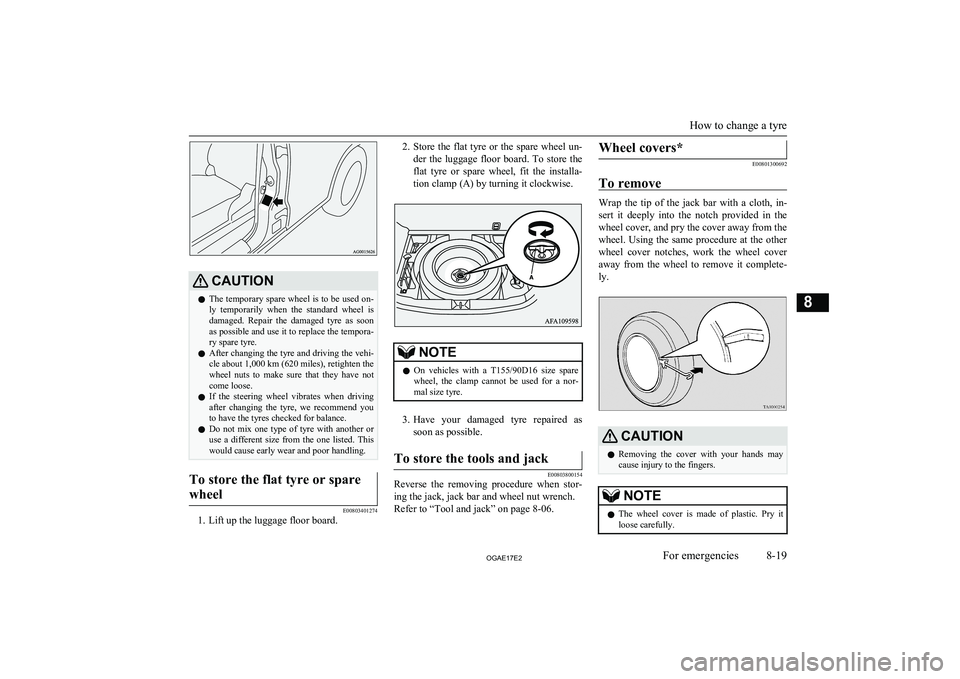
CAUTIONlThe temporary spare wheel is to be used on-
ly temporarily when the standard wheel isdamaged. Repair the damaged tyre as soon
as possible and use it to replace the tempora- ry spare tyre.
l After changing the tyre and driving the vehi-
cle about 1,000 km (620 miles), retighten the
wheel nuts to make sure that they have not come loose.
l If the steering wheel vibrates when driving
after changing the tyre, we recommend you to have the tyres checked for balance.
l Do not mix one type of tyre with another or
use a different size from the one listed. This would cause early wear and poor handling.To store the flat tyre or spare
wheel
E00803401274
1. Lift up the luggage floor board.
2. Store the flat tyre or the spare wheel un-
der the luggage floor board. To store the
flat tyre or spare wheel, fit the installa- tion clamp (A) by turning it clockwise.NOTEl On vehicles with a
T155/90D16 size spare
wheel, the clamp cannot be used for a nor-
mal size tyre.
3. Have your damaged tyre repaired as
soon as possible.
To store the tools and jack
E00803800154
Reverse the removing procedure when stor-
ing the jack, jack bar and wheel nut wrench.
Refer to “Tool and jack” on page 8-06.
Wheel covers*
E00801300692
To remove
Wrap the tip of the jack bar with a cloth, in- sert it deeply into the notch provided in the
wheel cover, and pry the cover away from the wheel. Using the same procedure at the other
wheel cover notches, work the wheel cover away from the wheel to remove it complete-
ly.
CAUTIONl Removing the cover with your hands may
cause injury to the fingers.NOTEl The wheel cover is made of plastic. Pry it
loose carefully.
How to change a tyre
8-19OGAE17E2For emergencies8
Page 348 of 458
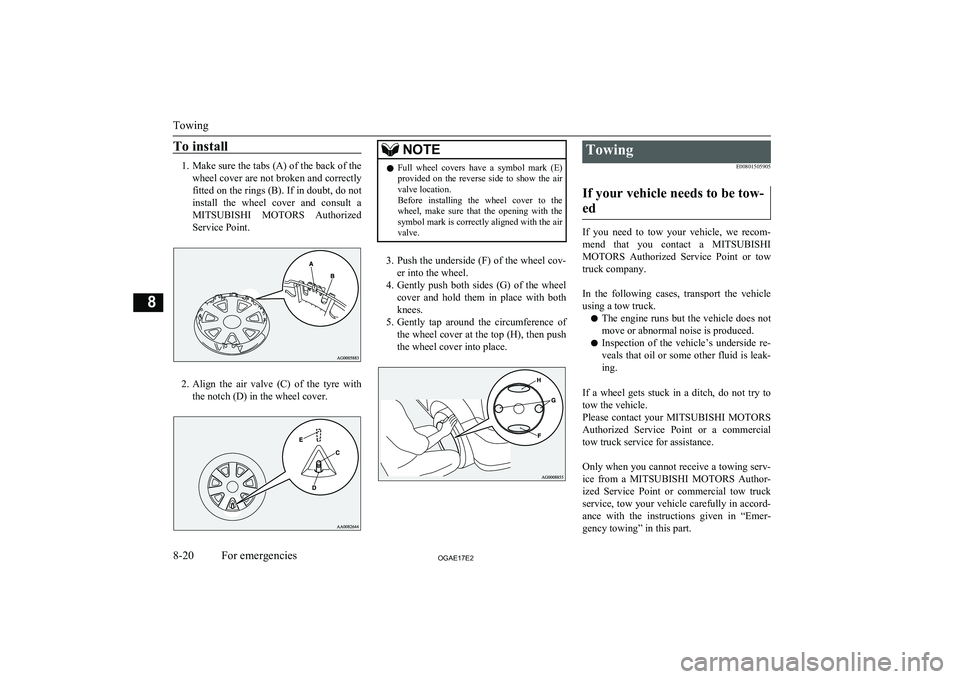
To install
1.Make sure the tabs (A) of the back of the
wheel cover are not broken and correctly fitted on the rings (B). If in doubt, do not install the wheel cover and consult aMITSUBISHI MOTORS Authorized
Service Point.
2. Align the air valve (C) of the tyre with
the notch (D) in the wheel cover.
NOTEl Full wheel covers have a symbol mark (E)
provided on the reverse side to show the air
valve location.
Before installing the wheel cover to the wheel, make sure that the opening with the
symbol mark is correctly aligned with the air valve.
3. Push the underside (F) of the wheel cov-
er into the wheel.
4. Gently push both sides (G) of the wheel
cover and hold them in place with both knees.
5. Gently tap around the circumference of
the wheel cover at the top (H), then push
the wheel cover into place.
Towing
E00801505905
If your vehicle needs to be tow- ed
If you need to tow your vehicle, we recom- mend that you contact a MITSUBISHI
MOTORS Authorized Service Point or tow
truck company.
In the following cases, transport the vehicle
using a tow truck.
l The engine runs but the vehicle does not
move or abnormal noise is produced.
l Inspection of the vehicle’s underside re-
veals that oil or some other fluid is leak- ing.
If a wheel gets stuck in a ditch, do not try to
tow the vehicle.
Please contact your MITSUBISHI MOTORS
Authorized Service Point or a commercial
tow truck service for assistance.
Only when you cannot receive a towing serv-
ice from a MITSUBISHI MOTORS Author-
ized Service Point or commercial tow truck service, tow your vehicle carefully in accord-
ance with the instructions given in “Emer- gency towing” in this part.
Towing
8-20OGAE17E2For emergencies8
Page 349 of 458
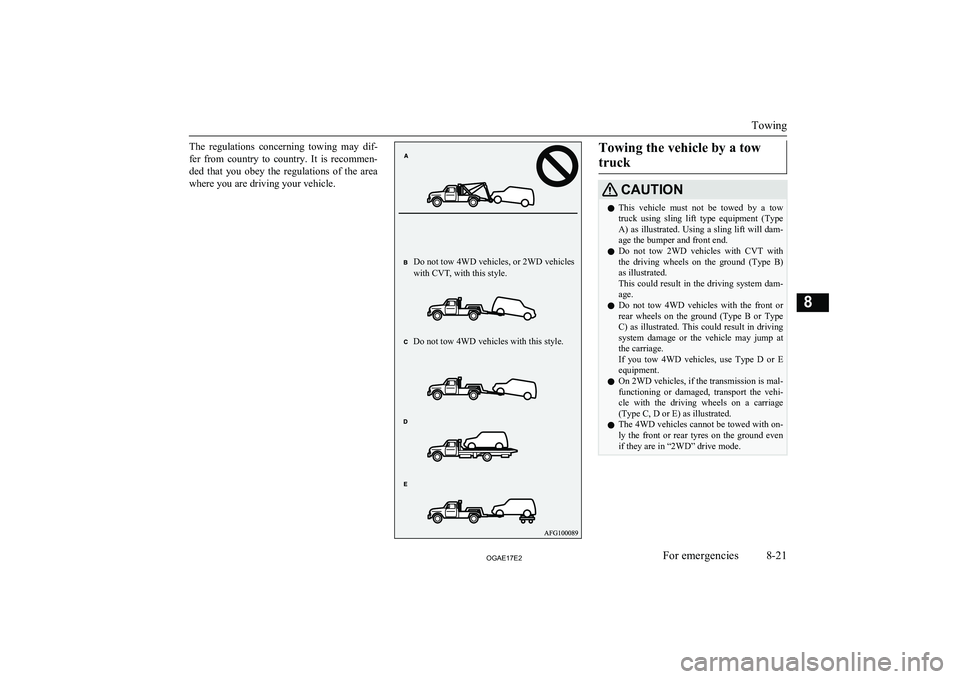
The regulations concerning towing may dif-
fer from country to country. It is recommen-
ded that you obey the regulations of the area where you are driving your vehicle.
Towing the vehicle by a tow
truckCAUTIONl This vehicle must not be towed by a tow
truck using sling lift type equipment (Type A) as illustrated. Using a sling lift will dam-age the bumper and front end.
l Do not tow 2WD vehicles with CVT with
the driving wheels on the ground (Type B) as illustrated.
This could result in the driving system dam- age.
l Do not tow 4WD vehicles with the front or
rear wheels on the ground (Type B or Type C) as illustrated. This could result in drivingsystem damage or the vehicle may jump at
the carriage.
If you tow 4WD vehicles, use Type D or E
equipment.
l On 2WD vehicles, if the transmission is mal-
functioning or damaged, transport the vehi- cle with the driving wheels on a carriage (Type C, D or E) as illustrated.
l The 4WD vehicles cannot be towed with on-
ly the front or rear tyres on the ground even
if they are in “2WD” drive mode.
Towing
8-21OGAE17E2For emergencies8Do not tow 4WD vehicles, or 2WD vehicles
with CVT, with this style.
Do not tow 4WD vehicles with this style.
Page 350 of 458
![MITSUBISHI ASX 2017 Owners Manual (in English) CAUTIONl[For 2WD vehicles equipped with the Active
Stability Control (ASC)]
If the vehicle is towed with the ignition switch in the “ON” position or the operation
mode in ON and only the fr MITSUBISHI ASX 2017 Owners Manual (in English) CAUTIONl[For 2WD vehicles equipped with the Active
Stability Control (ASC)]
If the vehicle is towed with the ignition switch in the “ON” position or the operation
mode in ON and only the fr](/img/19/34865/w960_34865-349.png)
CAUTIONl[For 2WD vehicles equipped with the Active
Stability Control (ASC)]
If the vehicle is towed with the ignition switch in the “ON” position or the operation
mode in ON and only the front wheels or on- ly the rear wheels raised off the ground (Type B or C), the ASC may operate, result-
ing in an accident.
When towing the vehicle with the rear wheels raised, turn the ignition switch to the
“ACC” position or put the operation mode in ACC.
When towing the vehicle with the front wheels raised, keep the ignition switch or the
operation mode as follows.
[Except vehicles equipped with keyless op- eration system]
The ignition switch is in the “LOCK” or
“ACC” position.
[Vehicles equipped with keyless operation system]
The operation mode is in OFF or ACC.
Towing with rear wheels off the
ground (Type B)
Place the gearshift lever in the “N” (Neutral)
position.
Turn the ignition switch to the “ACC” posi-
tion or put the operation mode in ACC and
secure the steering wheel in a straight-ahead position with a rope or tiedown strap. Neverplace the ignition switch in the “LOCK” po-
sition or put the operation mode in OFF when towing.
Towing with front wheels off the ground (Type C)
Release the parking brake.
Place the gearshift lever in the “N” (Neutral) position ( M/T) or the selector lever in the
“N” (Neutral) position (CVT).
Emergency towing
If towing service is not available in an emer-
gency, your vehicle may be temporarily tow- ed by a rope secured to the towing hook.
If your vehicle is to be towed by another ve- hicle or if your vehicle tows another vehicle,
pay careful attention to the following points:
If your vehicle is to be towed by
another vehicle
1. The front towing hook (A) is located as
shown in the illustration. Secure the tow
rope to the front towing hook.
NOTEl Do not use the tie-down hooks (B) for tow-
ing. These hooks are provided only for thepurpose of transporting the vehicle itself.
Using any part other than the designated
towing hook (A) could result in damage to
the vehicle body.
l Using a wire rope or metal chain can result
in damage to the vehicle body. It is best to
use a non-metallic rope. If you use a wire
rope or metal chain, wrap it with cloth at any point where it touches the vehicle body.
l Use care that the tow rope is kept as hori-
zontal as possible. An angled tow rope can
damage the vehicle body.
2. Keep the engine running.
If the engine is not running, perform the
following operation to unlock the steer- ing wheel.
[Except for vehicles equipped with key-
less operation system]
Towing
8-22OGAE17E2For emergencies8